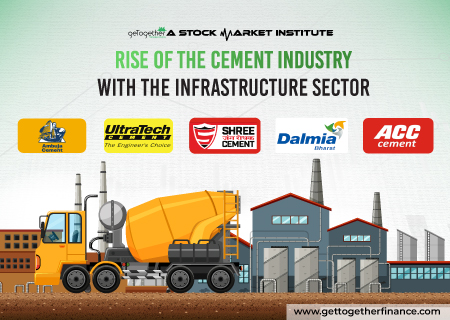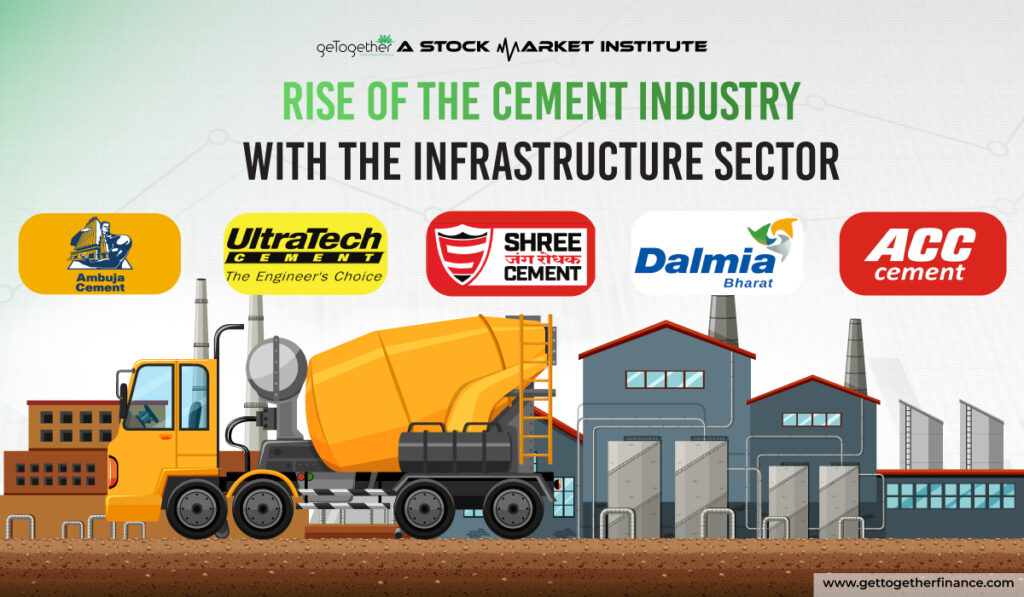Rise of the Cement Industry with the Infrastructure Sector


The cement industry plays a major role in the Indian economy. According to the forecast for 2023, India is the second-largest producer of cement in the world. Currently, India has more than 500 cement factories in the country that produce more than 500 million tons of cement every year.
The cement industry is extensively supporting employment and fostering regional development. Giving extreme support to the backbone of the Indian development sector, the Infra sector. It takes care of transport, energy, and urban development, facilitating economic growth, connectivity, and quality of life improvements.
This amazing sync between the cement industry and infrastructure development is a vital component in the growth of India; infrastructure projects increase cement demand, while efficient cement production ensures that the demand is fulfilled on time. This all together is promoting the cement industry, which eventually is giving a good rise to its stocks.
Together, these both sectors are rooting for the modernization and economic development of India, making their interdependence an important factor in the nation’s future development.
Table of Contents
ToggleEvolution of the Cement Industry in India

The Indian cement industry was organized in the 20th century with its first plan being established in 1902 in Chennai. Growth in the industry was a little slow in the initial days, it was heavily tampered with limited technology and demand. However, after independence, the industry witnessed a remarkable boom.
The reason behind this was governments focused on infrastructural development and urbanization to make India a developed nation. The incorporation of economic reforms in the 1990s further accelerated the growth of the industry, leading to rapid urbanization.
This all contributed immensely to making India the second-largest cement producer globally, with high-end and technology-led manufacturing processes and a competitive market.
Also Read: Infrastructure Sector
Major Milestones in Infrastructure Development

The infrastructure sector of India has seen many major milestones. If we go from the start, the construction of Grand Trunk Road in the ancient period laid the founding bricks in a network of roads connecting the country. After independence, the rapid development of the National Highway Authority of India (NHAI) in 1988 is said to be a significant step in systematic road development.
Next, the Golden Quadrilateral project was launched in 2001, it was responsible for changing the dynamics of road connectivity in some top cities of india. Following the Pradhan Mantri Gram Sadak Yojna (PMGSY); which was launched in 2000 it helped in rural connectivity of India, improving the economic development in remote areas. One of the recent projects was the Smart Cities Mission which is known for highlighting the ongoing commitment to the upliftment of urban and rural development.
These milestones reflect the critical role of infrastructure in India’s socioeconomic progress, and all this would not have been possible without the unwavering contribution of the cement industry, eventually leading to its upliftment of it too.
Role of the Cement Industry in Infrastructure Projects

Cement has always been a key ingredient in building roads, bridges, buildings, and dams. Cement acts as a binding element in concrete, providing strength and durability to the projects that are being constructed. Let’s accept the fact that without cement involvement, the long-lasting projects and the infrastructures we enjoy today won’t be possible. This clearly justifies the rise of the cement industry with infra.
Demand Drivers from the Infrastructure Sector
The majority of cement demand is generated by large businesses associated with the infra sector.
- Government projects like roads, trains, and housing complexes have resulted in a significant demand for cement.
- Also urbanization has a significant impact as more people move to cities, resulting in the construction of massive structures, offices, and transportation.
- The government programs such as the Smart Cities Mission and the Pradhan Mantri Awas Yojana (Housing for All) have boosted the use of concrete.
- On technical charts, if see the infrastructure sector, it is going pretty well, encouraging traders to put their trust in infra and related stocks. This eventually gave a good boost to the cement sector.
- Traders and investors are seeing it a as good investment since the demand is not increased in real life, but on technical charts too, leading to spiked-up prices.
Analysis of Leading Cement Companies

There are many key players that very well dominate the cement industry on the field and in the stock market too. Some famous names are UltraTech Cement, Shree Cement, Ambuja Cements, ACC Limited, and Dalmia Bharat.
Let’s know about the companies a bit:
- UltraTech Cement, cement company is a subsidiary of Aditya Birla Group and is said to be the largest cement producer in the country and tops the global list too.
- Next, Shree Cement is known for its sustainable business model
- ACC Limited is part of the Holcim Group, they have a strong brand name and significant recognition across the nation.
- Adani group has recently acquired major stakes in AMbuja Cement, which indicates it growth too.
- Lastly, Dalmia Bharat has a notable presence in the eastern and southern regions of India due to its green initiatives.
Stock Market Performance of Cement Companies
The stock market performance of these important cement companies has generally been positive because of continuous demand and strong infrastructure development. UltraTech Cement and Shree Cement reported strong financial performance, with sales increasing and profit margins expanding.
Ambuja Cements and ACC Limited achieved success through joint ventures and market organization. The pricing of these companies’ products frequently climbs in response to government spending and favorable economic news.
Future Growth Prospects
India’s cement sector is aiming for long-term growth opportunities. The government’s focus on infrastructure, affordable housing via home leans, and smart city projects are all signaling the boost in demand for cement. Other the other hand, rural and urbanization strategies will also increase the demand.
Investments in sustainable and green technologies will also be needed as businesses are working hard to minimize their carbon footprint and increase their operational efficiency.
This is why a greater focus on renewable energy and heat recovery technology is needed, it will help in both cost-saving and environmental benefits.
Technical Analysis of the Cement Sector
Technical analysis refers to the study of candlestick charts. It involves identifying demand and supply based on them. If we look at the whole sector, the cement sector goes in sync with the infra sector.
The Infra sector has been going well for the past few years, on chart it has seen a significant upward rally. The stocks in the cement sector are going up in a similar way. The demand has increased significantly, leading to increased stock price.
Top Cement Companies to Invest in 2024

Here’s a table highlighting some of the top cement stocks in India, along with relevant details like market capitalization, current price (as of the latest available data), and key financial metrics.
| Company | Market Cap (INR Cr) | Current Price (INR) | P/E Ratio | Dividend Yield (%) | EPS (INR) |
| UltraTech Cement | 221,000 | 7,630 | 37.5 | 0.35 | 203.5 |
| Shree Cement | 89,000 | 26,800 | 55.3 | 0.24 | 484.5 |
| Ambuja Cements | 76,000 | 390 | 29.2 | 0.92 | 13.4 |
| ACC Limited | 46,000 | 2,450 | 25.8 | 1.15 | 95.0 |
| Dalmia Bharat | 34,000 | 1,850 | 30.6 | 0.17 | 60.5 |
| Ramco Cements | 21,000 | 1,020 | 28.7 | 0.41 | 35.5 |
| JK Cement | 20,000 | 3,150 | 31.9 | 0.53 | 98.7 |
| India Cements | 6,500 | 215 | 35.2 | 0.67 | 6.1 |
Notes:
- Market Cap: Market capitalization in crore INR.
- Current Price: Stock price as of the latest available data.
- P/E Ratio: Price-to-Earnings ratio.
- Dividend Yield: Annual dividend divided announced by the company, denoted in percentage
- EPS: Earnings per share in INR.
Conclusion
The cement industry and infrastructure industry has always been interconnected and said to be one of the most imrptoant sector for india. As the demand of cement is continuously growing, the industry;s development future is looking bright. Big cement companies like UltraTech Cement, Shree Cement, and Ambuja Cement are said to benefit from this connection between the industries. Also, many government policies focus on urban development, rural development, and sustainability, this shows how the government is involved inthe bright future of infra development. These are the reason why cement stocks are performing well from past few years in the stock market.
FAQs
Why is the cement industry crucial to India’s economy?
Cement industry is very important to the Indian economy as it plays a major role in infrastructure development leading to job creation and regional prosperity. It is also necessary for the construction of roads, bridges and buildings.
What are the main factors driving cement demand in India?
Government infrastructure projects and urbanisation initiatives such as the smart cities mission and Mantri Awas Yojana increase cement demand in india. These projects demand high amount of cement building, which boosts the industry’s expansion.
Who are the top cement companies in India?
The top cement manufacturers in India are UltraTech cement, Shree cement, Ambuja cement, ACC Limited, and Dalmia Bharat. These companies have a high market value and dominate the market with their high productivity and good financial results.
How has the stock market performance of the cement industry been?
The strong performance of all major cement companies in the stock market in recent years is due to stable demand and increased domestic production. Companies like UltraTech Cement and Shree Cement have seen economic growth and productivity growth.
What are the future growth prospects for the cement industry in India?
The cement sector in india has significant future growth prospects, this is because of government policies that are encouraging infrastructure development. Investment in sustainable technologies and urbanization is said to increase the cement industry’s growth.



 Instagram
Instagram
